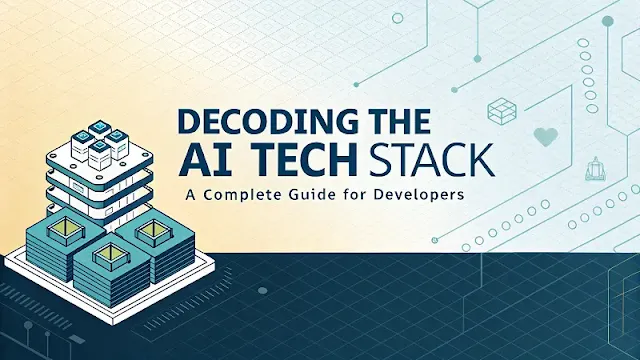The AI stack is a core component of current AI agent development, which offers the tools, platforms, and systems that make agents reason, act, and adapt. The different levels of the stack have their own unique functions, starting with data collection to serving models, and it is vital to know these levels to develop high-performing and reliable AI agents.
This guide follows the AI tech stack layer by layer, placing emphasis on its components, functions, and most popular platforms.
1. Data Collection and Integration: The Foundation of AI Agents
Data collection and integration is the initial stage in the process of developing any AI agent. Agents are unable to make informed decisions without real-time, accurate and context rich data.
- Purpose: To put agents into context to enable them to work well.
- Types of Data: Real world, real-time and frequently unstructured data.
- Techniques: Pre-trained models, Retrieval-augmented generation (RAG) models and real-time streams of data to make decisions.
Example Platform Bright Data provides web data collection infrastructure on a large scale. Its Search API allows the ranking of the related information in real time without triggering anti-bot blockades, which guarantees continuous data delivery.
2. Vertical Agents: Industry-Specific AI Solutions
Vertical agents are AI agents that are pre-trained to handle specific industry and tasks. They conserve the development time and provide domain-specific capabilities.
- Purpose: Provide industry solutions to industries such as law, finance, healthcare and customer service.
- Social Web Sites: Perplexity AI, Replit, MultiOn, Harvey, Factory, Dosu, Cognition, and Adapt.
With the vertical agent integration into the AI technology stack, developers can deploy it faster and enhance accuracy in the tasks.
3. Agent Hosting and Serving: Running AI in Production
After an agent can access the data, it requires a hosting and serving environment to make actions and decisions.
- Purpose: Use, maintain and implement AI agents in a secure, scalable environment.
- Famous Platforms Amazon Bedrock Agents, AWS SageMaker, Azure Machine Learning.
This layer converts non-living agents to living, working systems that are able to communicate with the real world.
4. Observability: Monitoring and Transparency
Observability makes AI agents transparent, traceable and trustworthy.
- Purpose: Track performance, trace decision-making and trouble shoot problems.
- Popular Tools Arize, AgentOps.ai, LangSmith, New Relic, Prometheus, Grafana Loki.
Using observability tools, developers are able to maintain compliance, enhance reliability and optimize the behavior of agents as they age.
5. Agent Frameworks: Structuring AI Development
The agent frameworks determine the way agents are constructed, communicate and reason. They play a key role in complex undertakings such as multi agent systems and dynamic planning.
- Intention: Deliver blueprints of scalable and sustainable AI systems.
- Famous Frameworks Crew AI (agent cooperation), LangGraph (compound logic of complicated actions).
Frameworks are simpler to develop with and large-scale AI is easier to manage.
6. Memory: Context Retention for Smarter Agents
The memory layer enables agents to recall previous interaction, decision-making and information so that measurements can become more personalized and effective.
- Purpose: Continue context, in order to continue improvement and personalisation.
- Government Sites: Qdrant, ChromaDB, MemO, MemtGPT, Pinecone, Milvus, Zep.
The development of agents who learn and evolve with time depends on memory.
7. Storage: Long-Term Data Management
Whereas memory deals in short- to medium-term retention, data persistence is long-term and is dealt with by storage.
- Purpose: Store real-time data, keep logs and make it reproducible.
- Popular Platforms Chroma, MongoDB, Supabase, PostgreSQL, Redis, Neon.
Storage makes sure that there is compliance and helps with historical analysis of AI workflows.
8. Tool Libraries: Extending Agent Capabilities
Tool libraries provide the agents the capability to communicate with external systems and services allowing them to make real-world actions.
- Purpose: Go beyond core reasoning as the functionality of agents.
- Doing Tools: Postman, Puppeteer, Unstructured, n8n.
The agents would only be allowed to passively process data without tool libraries.
9. Sandboxes: Safe Testing Environments
Sandboxes are isolated environments with which agents can write, test and execute code in isolation of live systems.
- Purpose: Get safe experimentation, debugging and data analysis.
- Popular Repos: Popiter, RunPod, CodeSandbox.
Sandboxes are required to test the behavior of agents before they can be deployed.
10. Model Serving: Powering Language and Decision-Making
The serving model contains large language models (LLMs) and other AI models which drive agent reasoning and decision-making.
- Purpose: Offering the compute power of natural language processing and predictive analytics.
- Emerging Services: Colab Pro, Fireworks AI, groqcloud, VLLM, together.ai.
Model serving will guarantee the accessibility of the newest AI abilities to agents.
Key Takeaways for Developers
- The basis is data: The other components of the stack are unable to work effectively without the presence of solid data collection and union.
- The issue of layer synergy: Every layer of vertical agents to model serving functions in collaboration to produce a practical, flexible AI system.
- One choice affects performance: The choice of the tools at each level can greatly enhance the efficiency of the agents and its reliability.
With a perfect command of the AI tech stack, developers will be able to create agents that are not only intelligent but can also be used to create scalable, transparent, and adaptable agents to changing environments.


